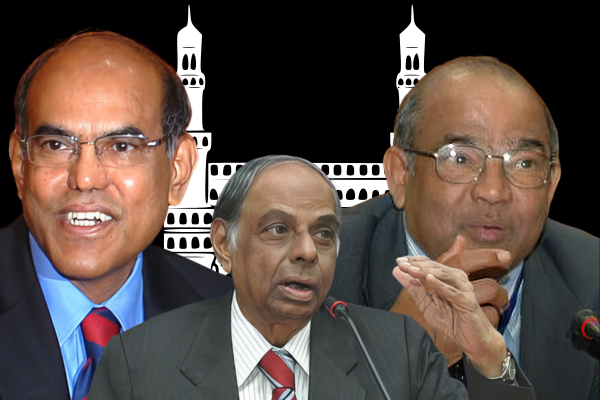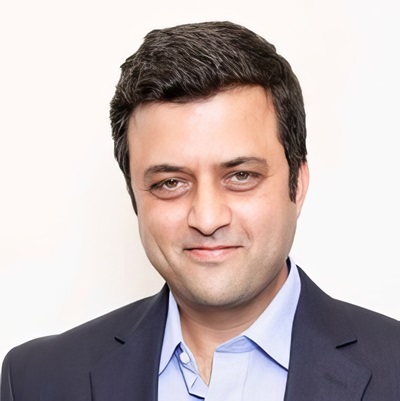.png)
Hyderabad Blues: Central Banking Memories And Quiet Returns
A hometown visit turns into a quiet reckoning with central banking’s past, as two former RBI Governors open their doors and their minds.


Kalyan Ram, a financial journalist, co-founded Cogencis and now leads BasisPoint Insight.
June 8, 2025 at 2:05 PM IST
There are cities that stay with you, not because of what they promise, but because of what they allow you to remember. Hyderabad has always been that kind of city for me. A hometown, yes, but also a threshold, between past and present, between reporting and reflecting, between the questions I asked as a greenhorn and the ones I now ask with softer edges.
I was back in Hyderabad recently, chasing not a story but a memory.
Two, in fact. I had the privilege of interviewing Dr Chakravarthy Rangarajan and Dr Duvvuri Subbarao within the span of a few days. Two former Governors of the Reserve Bank of India, two minds shaped by entirely different moments in India’s economic journey, but united by a certain clarity: about policy, about purpose, and, surprisingly, about Hyderabad itself.
Dr Rangarajan met me at ICFAI University, on the fringes of the city. He is 93, but the mind, my god, the mind, is still a metronome of precision. Listening to him speak, one could forget the distance between 1997 and now.
It was on his last day as RBI Governor in Mumbai that I had my first in-person encounter with him, a brief, wide-eyed moment.
I had attended a few press conferences before, back when they were still called “Credit Policy Statements.” I don’t remember if it was the busy or slack season. I was still learning what CRR stood for, fumbling through Bank Rate and export-credit refinance with help from kind bankers who tolerated rookie calls.
And now, decades later, I was back in his presence. Older, less hurried, still searching, but for different things.
Dr Subbarao welcomed me at his home near Kukatpally Housing Board, in a part of Hyderabad that is not freshly minted but close enough to the city’s expanding business district to feel its quiet pull. He served tea, ensured my camera person and I were fed, and stuck to warm water for himself, as if guarding some quiet discipline.
The conversation was homely, the kind that winds its way through ideas without ever losing civility. I wasn’t there as a journalist. Not quite. I was someone who had once tried to understand the central bank by chasing soundbites, and now sought something slower, more enduring. Every word he says, even in casual conversation, is well considered and dignified. At some point, I shared with him that we hail from the same native place in the West Godavari district. It felt less like disclosure, more like quiet recognition.
What struck me was not just what they said, but how they said it, without rancour, without fatigue, and most crucially, without nostalgia masquerading as critique. Both Dr Rangarajan and Dr Subbarao acknowledged the progress India has made, but warned that the next phase would need something deeper than reforms.
It would need statesmanship.
They both returned, in different ways, to an old but underemphasised truth: that the Centre cannot carry India alone. That federal cooperation is not just a constitutional ideal but an economic necessity. The next generation of reforms, the ones that will decide whether India can genuinely call itself developed by 2047, will have to care for all the factors of production. Not just capital, not just labour, but trust, distribution, and dignity.
And here’s where the musing turns inward.
Listening to these doyens of public policy, each offering gentle provocations and institutional memory, I couldn’t help but reflect how far I had travelled from those days of chasing RBI Governors across corridors and conferences.
Once upon a time, we wire reporters would trail them to various cities, hoping for a soundbite, a quote, a hint of what the next policy might bring.
I remember one such visit to the Administrative Staff College of India in the Khairtabad area of Hyderabad. Dr Y. V. Reddy spotted me — I was a familiar face from Mumbai’s press briefings — and asked, with a wry smile, “What are you doing here?” I muttered something about visiting home. “Good,” he replied, “we are here for the same reason.”
As I recall that encounter, it said something about both Hyderabad and the men who shaped Indian monetary policy in the early years of liberalisation. For all their gravitas, their intellectual heft, there was something grounded about them, something quietly Hyderabadi.
Dr Rangarajan left the RBI to become the Governor of the undivided Andhra Pradesh. Searching for deeper connections, I said one of my professors from the University of Hyderabad was well known to him. Twenty years on, he remembered my Econometrics professor and said he wrote the foreword to a book he had edited. Though now a resident of Chennai, Dr Rangarajan is a frequent visitor to Hyderabad, with family here and academic engagements at ICFAI.
Hyderabad is not a place that insists on being the headline. It prefers being the dateline. It lets things unfold. It gives space. Whether it was CRR hikes or inflation-targeting debates, forex interventions, or financial inclusion goals, the city seemed to stand as a kind of tacit co-author in the lives of these Governors, a city of origins, returns, and unspoken continuities.
And the city has changed, not abruptly, but in a way only Hyderabad can, with a kind of unhurried certainty. From the slow charm of Domalguda, where mornings still belong to walkers, newspapers, and the wafting aroma of fresh Osmania biscuits, to the angular ambition of Cyber Towers and the quiet hum of biotech parks, Hyderabad has stretched itself without snapping.
Whenever I visit, I make it a point to trace the outline of my student-days city, even as I try to make sense of the steel and glass that now rises across the financial district. It has, as someone once said, found a way to code the future without deleting its past. There is a peculiar comfort in that, knowing that a city can hold both an Urdu sher and an AI lab without ever feeling the need to choose between them.
Even the geography of learning has shifted. The Hyderabad I remember from my student days was still contained, walkable, centered around old university neighbourhoods. Now, the city’s universities have sprawled outward, along with research centres and startup campuses that lie tucked behind long drives on the ORR. The very idea of distance has changed — and yet, somehow, the city still feels held together.
I found myself wondering what it would be like to speak next with Dr Reddy. His tenure was perhaps the one I reported on most closely, between seminars, policy reviews, and those complex times of sterilisation bonds and dollar purchases. I hope he agrees to meet, not just for an interview, but to continue a quiet conversation with central banking, and with myself.
There’s a phrase I’ve often returned to: “The hunter becomes the elder who stayed home.” That’s how it feels sometimes. To hand over the RBI keys to sharper, more tireless juniors. To watch from a distance as debates rage, corridors shift, and the monetary stance turns with the cycle.
But this recent trip, these conversations, gave me back a fragment of that old self. Not the hunter, no. But perhaps the keeper of stories.
It is not always easy to describe what Hyderabad means to someone who hasn’t lived it. It isn’t a city that dazzles. It doesn’t seduce with its skyline, though many would say it does now. What it does offer is something subtler, the gift of time, of return, of being able to say: I was here when it mattered.
And now, as I wait in hope for a meeting with Dr Reddy, I realise I am not chasing closure. Only continuation. Between Hyderabad and Mumbai, between memory and meaning.



